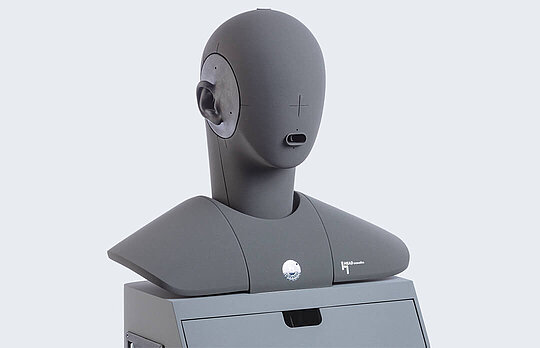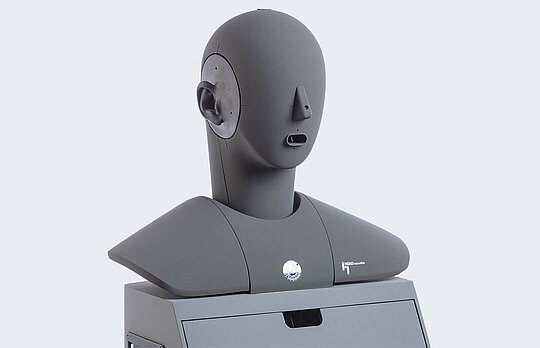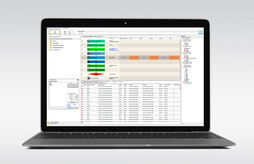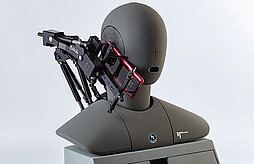HMS II.3 – Fullband artificial head complying with all relevant standards
HMS II.3 is the fullband artificial head ideal for measuring voice and audio quality of...
HMS II.3 is the fullband artificial head ideal for measuring voice and audio quality of close-to-the-ear audio and telecommunication devices (e.g. mobile phones, handsets, ANC headphones/headsets, smart speaker). In addition, the artificial head allows measurements even of far-to-the-ear communication devices like hands-free systems or smart speakers. The head and torso simulator provides geometric and acoustic characteristics according to recommendation ITU-T P.58 and thus replicates all acoustically relevant structures of the human anatomy.
HMS II.3 supports measurements in sending and receiving direction. For this purpose, the artificial head is equipped with an artificial ear on the right side and a two-way mouth loudspeaker – both meeting the requirements in the recommendations ITU-T P.57 and P.58. With HMS II.3, users can create aurally accurate voice and audio recordings for analysis with the measurement and analysis software ACQUA. The artificial mouth reproduces the complete spectrum of human voice, allowing narrowband, wideband, super-wideband and even fullband measurements.
HMS II.3 is characterized by the newly introduced modular concept, which applies to all HEAD acoustics artificial heads in the field of communication and audio quality testing. From now on, it is possible to use one artificial head for altering applications. Users can quickly and easily change occluded ear simulators and pinnae based on their measurement task.
HMS II.3 is the fullband artificial head ideal for measuring voice and audio quality of close-to-the-ear audio and telecommunication devices (e.g. mobile phones, handsets, ANC headphones/headsets, smart speaker). In addition, the artificial head allows measurements even of far-to-the-ear...
HMS II.3 is the fullband artificial head ideal for measuring voice and audio quality of close-to-the-ear audio and telecommunication devices (e.g. mobile phones, handsets, ANC headphones/headsets, smart speaker). In addition, the artificial head allows measurements even of far-to-the-ear communication devices like hands-free systems or smart speakers. The head and torso simulator provides geometric and acoustic characteristics according to recommendation ITU-T P.58 and thus replicates all acoustically relevant structures of the human anatomy.
HMS II.3 supports measurements in sending and receiving direction. For this purpose, the artificial head is equipped with an artificial ear on the right side and a two-way mouth loudspeaker – both meeting the requirements in the recommendations ITU-T P.57 and P.58. With HMS II.3, users can create aurally accurate voice and audio recordings for analysis with the measurement and analysis software ACQUA. The artificial mouth reproduces the complete spectrum of human voice, allowing narrowband, wideband, super-wideband and even fullband measurements.
HMS II.3 is characterized by the newly introduced modular concept, which applies to all HEAD acoustics artificial heads in the field of communication and audio quality testing. From now on, it is possible to use one artificial head for altering applications. Users can quickly and easily change occluded ear simulators and pinnae based on their measurement task.
Highlights
- HMS II.3 is ideally suited for fullband measurements of close-to-the-ear and far-to-the-ear audio and communication devices under realistic conditions.
- The artificial head enables binaural recordings to evaluate acoustic scenarios aurally accurate (requires optional occluded ear simulator HIS L for the left ear).
- HMS II.3 complies with all relevant international standards like recommendations ITU-T P.57, P.58 as well as IEC 60318-4.
- Modular concept allows to adapt the artificial head quickly and easily to altering measurement tasks.
Applications
- Voice quality and audio quality testing of e.g.:
- Mobile phones and handsets
- Headsets, headphones like in-ear buds, and wearables – with and without Active Noise Cancellation (ANC)
- Hearing aids and active/passive hearing protection
- In-vehicle applications like hands-free terminals, in-car communication (ICC) systems, infotainment systems, emergency call (eCall) devices
- Voice-controlled smart home devices like smart speakers and other IoT devices
- Conference phones and hands-free devices
Features
Artificial ears:
- HMS II.3 is equipped with an occluded ear simulator in the right ear (HIS R) – optionally, it is possible to add an occluded ear simulator in the left ear (HIS L).
- Due to its modular concept, HMS II.3 is configurable as desired to fit altering measurement tasks:
- Further variants of the occluded ear simulator are available:
- Low-noise occluded ear simulators that feature an impedance response matched to that of the human ear for the right ear (HIS R LN HEC) and for the left ear (HIS L LN HEC).
- Low-noise occluded ear simulators for the right ear (HIS R LN) and for the left ear (HIS L LN).
- Pinna: HMS II.3 is equipped with two anatomically shaped pinnae (ITU-T type 3.3) and can be retrofitted with simplified pinnae (ITU-T type 3.4). Also, human-like designed pinnae (ITU-T type 4.4) that models the section leading into the realistic ear canal are available.
- Further variants of the occluded ear simulator are available:
- The artificial ears provide a transmission range from 3 Hz to 20 kHz.
- The artificial ears ITU-T type 3.3, 3.4 and 4.4 meet the requirements in the recommendation ITU-T P.57 – ITU-T type 4.4 fulfills the low-noise requirements in chapter 7of ITU-T P.57. Additionally, the occluded ear simulator complies with IEC 60318-4.
Artificial mouth:
- The artificial mouth with its two-way loudspeaker design transmits equalized speech signals from 50 Hz up to 20 kHz – from narrowband to fullband.
- The two-way mouth simulator of the artificial head also reproduces high speech levels with low distortion.
- Acoustic properties of the two-way mouth exceed the requirements of the recommendation ITU-T P.58.
- Automated and comfortable equalization of the two-way mouth simulator is supported in the measurement and analysis software ACQUA.
Artificial nose:
- HMS II.3 can be equipped with an artificial nose (AN-HMS); it enables acoustic measurements of audio and communication devices where a nose ensures secure hold of various devices (e.g. augmented reality glasses, virtual reality headsets).
- Users can mount all artificial head variants on the height-adjustable tripod HMT III or on the torso box HTB VI.












